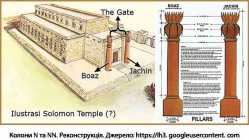[288 / 124 / ?]
Quoted By: >>20508606 >>20508620 >>20508622 >>20508639 >>20508649 >>20508651 >>20508654 >>20508655 >>20508658 >>20508663 >>20508664 >>20508671 >>20508672 >>20508675 >>20508688 >>20508692 >>20508693 >>20508703 >>20508730 >>20508741 >>20508831 >>20508835 >>20508841 >>20508843 >>20508855 >>20508856 >>20508857 >>20508874 >>20516670
The oldest historically recorded temple in Jerusalem was a temple to Ninib (Ninurta):
https://jewishencyclopedia.com/articles/8604-jerusalem
>In the El-Amarna Tablets
>The earliest historical notices respecting Jerusalem come from the El-Amarna tablets. Before the fifteenth century B.C. Babylonian influences must have been present. There was a city called "Bit-Ninib" (Temple of the God Ninib) in the "district of Jerusalem "(Letter 180, 25)
Both Herodotus and Lucian claimed to visit the temple of Melqart in Phoenicia and both concluded that there were two different deities called Heracles - one the Olympian and the other "Tyrian Heracles" (Melqart/Ninurta). Yahweh's temple was EXPLICITLY modeled after Melqart's temple with his two pillars at the entrance (Hercules pillars that separate the Mediterranean Sea from the Atlantic Ocean). Also, the foundation myth of Tyre includes a burning tree that wasn't consumed, with a serpent around its base. Clear biblical parallels. Many many other connections. This is true, because people from Tyre built Solomon's temple. Even the king of Tyre, Hiram is referred to as a "brother" (achi) by David, and Josephus stated that he was of the tribe of Naphtali.
https://www.academia.edu/4354912/The_Ambrosial_Rocks_and_the_Sacred_Precinct_of_Melqart_in_Tyre_In_C_Alfaro_C_Marcos_and_P_Otero_eds_XIII_Congreso_Internacional_de_Numismatica_Madrid_2003_Actas_Proceedings_Actes_I_Madrid_2005_Pp_829_834
https://jewishencyclopedia.com/articles/8604-jerusalem
>In the El-Amarna Tablets
>The earliest historical notices respecting Jerusalem come from the El-Amarna tablets. Before the fifteenth century B.C. Babylonian influences must have been present. There was a city called "Bit-Ninib" (Temple of the God Ninib) in the "district of Jerusalem "(Letter 180, 25)
Both Herodotus and Lucian claimed to visit the temple of Melqart in Phoenicia and both concluded that there were two different deities called Heracles - one the Olympian and the other "Tyrian Heracles" (Melqart/Ninurta). Yahweh's temple was EXPLICITLY modeled after Melqart's temple with his two pillars at the entrance (Hercules pillars that separate the Mediterranean Sea from the Atlantic Ocean). Also, the foundation myth of Tyre includes a burning tree that wasn't consumed, with a serpent around its base. Clear biblical parallels. Many many other connections. This is true, because people from Tyre built Solomon's temple. Even the king of Tyre, Hiram is referred to as a "brother" (achi) by David, and Josephus stated that he was of the tribe of Naphtali.
https://www.academia.edu/4354912/The_Ambrosial_Rocks_and_the_Sacred_Precinct_of_Melqart_in_Tyre_In_C_Alfaro_C_Marcos_and_P_Otero_eds_XIII_Congreso_Internacional_de_Numismatica_Madrid_2003_Actas_Proceedings_Actes_I_Madrid_2005_Pp_829_834

